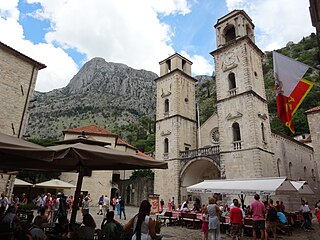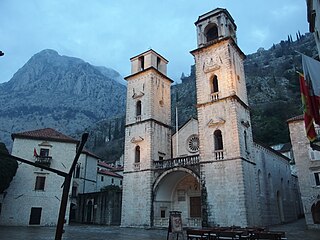
Montenegro is a country in Southeastern Europe, on the Balkan Peninsula. Its 25 municipalities have a total population of 633,158 people in an area of 13,812 km2. It is bordered by Bosnia and Herzegovina to the northwest, Serbia to the northeast, Kosovo to the east, Albania to the southeast, Croatia to the west, and has a coastline along the Adriatic Sea to the southwest. The capital and largest city is Podgorica, while Cetinje is the Old Royal Capital and cultural centre.

Vraka is a region in Shkodër County in northern Albania. The region includes settlements located on the shore of Lake Scutari, some 7 km north of the city of Shkodër. This ethnographic region is inhabited by Serb-Montenegrins, Podgoriçani and Albanians; it used to be mainly inhabited by Serb-Montenegrins. A small Serbo-Montenegrin community migrated and established itself in Vraka during the late seventeenth and early eighteenth centuries. The majority of the Serbo-Montenegrin community came to Vraka, Albania from Montenegro during the interwar Zogist period following 1926 and later from 1938 until 1948. By the year 2010 most of the Orthodox families returned to Montenegro and Serbia. As of 2019, there are only a few families living there.
The demographic history of Montenegro can be shown through census results and official documents which mention demographic composition.

The Democratic Union of Albanians is a conservative political party of the Albanian minority in Montenegro.

The Vasojevići is a historical highland tribe (pleme) and region of Montenegro, in the area of the Brda. It is the largest of the historical tribes, occupying the area between Lijeva Rijeka in the South up to Bihor under Bijelo Polje in the North, Mateševo in the West to Plav in the East. Likely of Albanian origin, most of the tribe's history prior to the 16th century has naturally been passed on through oral history.

The Kingdom of Montenegro was a monarchy in southeastern Europe, present-day Montenegro, during the tumultuous period of time on the Balkan Peninsula leading up to and during World War I. Officially it was a constitutional monarchy, but absolutist in practice. On 28 November 1918, following the end of World War I, with the Montenegrin government still in exile, the Podgorica Assembly proclaimed unification with the Kingdom of Serbia, which itself was merged into the Kingdom of Serbs, Croats and Slovenes three days later, on 1 December 1918. This unification with Serbia lasted, through various successor states, for almost 88 years, ending in 2006.

Demographic features of the population of Montenegro include population density, ethnicity, education level, health of the populace, economic status, religious affiliations and other aspects.

Kolašin is a town in northern Montenegro. It has a population of 2,989. Kolašin is the centre of Kolašin Municipality and an unofficial centre of Morača region, named after Morača River.
Albanians in Montenegro are ethnic Albanians who constitute 4.97% of Montenegro's total population. They belong to the ethnic Albanian sub-group of Ghegs, and they are the largest non-Slavic ethnic group in Montenegro.

Islam in Montenegro refers to adherents, communities and religious institutions of Islam in Montenegro. It is the second largest religion in the country, after Christianity. According to the 2011 census, Montenegro's 118,477 Muslims make up 20% of the total population. Montenegro's Muslims belong mostly to the Sunni branch. According to the estimate by the Pew Research Center, Muslims have a population of 130,000 (20.3%) as of 2020.

The current Constitution of Montenegro was ratified and adopted by the Constitutional Parliament of Montenegro on 19 October 2007 in an extraordinary session by achieving the required two-thirds supermajority of votes. It was officially proclaimed on 22 October 2007, replacing the constitution of 1992.

The Catholic Church in Montenegro is part of the worldwide Catholic Church, under the spiritual leadership of the Pope in Rome. Montenegro is not a traditionally Catholic country, as after the Great Schism of 1054 the Montenegrin Christians remained within the sphere of influence of the Church of Constantinople.

Eastern Orthodox Christianity is the largest religion in Montenegro at 71% of the population, and is the religion of choice for the vast majority of ethnic Montenegrins and Serbs. In addition to Eastern Orthodox Christianity, there is also a sizeable number of adherents to Sunni Islam at 20% of the population, mainly from ethnic Bosniaks and Albanians.
Serbs and Montenegrins (Serbs-Montenegrins) are an ethno-linguistic community in Albania. They are one of the recognized national minorities. The population was concentrated in the region of Vraka, but largely emigrated in the 1990s. The community is bilingual and by majority adhere to Eastern Orthodoxy, while a minority professes Islam. The majority of the Serbo-Montenegrin community came to Albania from Montenegro during the interwar Zogist period following 1926 and later from 1938 until 1948. In the latest census (2023) 511 citizens declared themselves as Montenegrins and 586 as Serbs.

The Italian governorate of Montenegro existed from October 1941 to September 1943 as an occupied territory under military government of Fascist Italy during World War II. Although the Italians had intended to establish a quasi-independent Montenegrin kingdom, these plans were permanently shelved after a popular uprising in July 1941. Following the Italian surrender in September 1943, the territory of Montenegro was occupied by German forces which withdrew in December 1944.

The siege of Scutari, also referred to as the siege of Shkodër, known in Turkish as İşkodra Müdafaası(in Turkish) or İşkodra Savunması, took place from 28 October 1912 to 23 April 1913 when the army of the Kingdom of Montenegro defeated the forces of the Ottoman Empire and invaded Shkodër.
Grilë is a settlement in the former Gruemirë municipality, Shkodër County, northern Albania. At the 2015 local government reform it became part of the municipality Malësi e Madhe. It is part of the Vraka region, and is inhabited by a minority of Montenegrins, who call the village Grilj.
Darza is a village in the municipality of Ulcinj, southeastern Montenegro. It is a multi-ethnic settlement, inhabited by Montenegrins, Serbs and Albanians.

Battle of Ulcinj took place between the Ottoman forces of Dervish Pasha and Albanian irregulars in the year of 1880 at the region of Kodra e Kuqe, close to Kllezna. The area of Plav and Gusinje had been ceded to Montenegro according to the Treaty of Berlin (1878), but the Albanians fought against the annexation. The Great Powers then persuaded the Ottomans to cede the area of Ulcinj, but the Albanians yet again refused. Eventually, the Great Powers commanded the Ottomans to take actions against the League of Prizren, ending the resistance and successfully handing over the town of Ulcinj to Montenegro.
Vladimir is a village in the municipality of Ulcinj, Montenegro.














